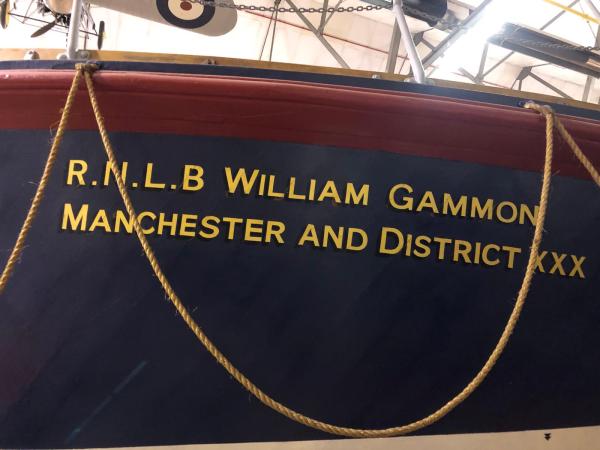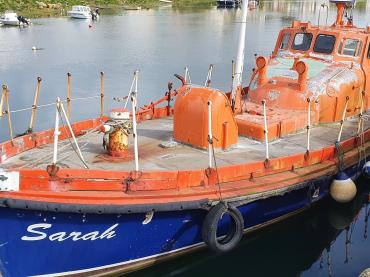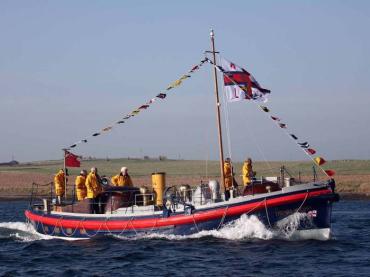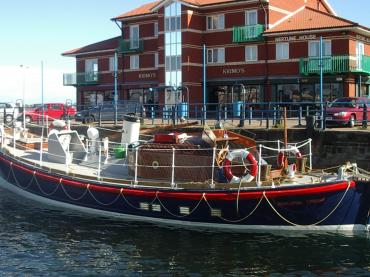

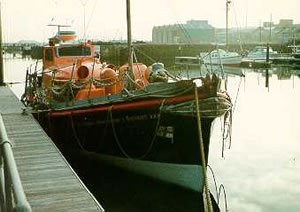
Previous names
- Manchester & District XXX
Details
Construction
Dimensions
History
WILLIAM GAMMON was originally called the MANCHESTER AND DISTRICT XXX, being the 30th lifeboat provided by the fund. The name was changed to commemorate the courage of the coxswain who was lost together with his crew in April 1947 when the Mumbles lifeboat EDWARD PRINCE OF WALES capsized off Sker Point.
WILLIAM GAMMON is unsinkable, rather than being self-righting and this is why she was withdrawn from service. Since 1970, all RNLI lifeboats over 30ft long have been self-righting. There has also been a trend to replace post war classes such as the Watsons, Liverpools and Barnetts by more powerful lifeboats.
WILLIAM GAMMON's first service launch was 11 November 1947 when she went to the assistance of the Barnstaple ketch ENID which had run aground at Aberavon. Its most famous rescue was of the motor vessel KILO after which the lifeboat required extensive repairs to stanchions, stern and belting. KILO had caught fire when her deck cargo of sodium drums had been damaged in a hurricane and the sodium exploded on contact with water.
Other services included Christmas parcels to the crew of the Scarweather Lightship and saving horses. WILLIAM GAMMON was replaced on the Mumbles station by the PENTLAND - Civil Service 31 which was a 17 year old 47ft Watson Class boat which had been converted to self-righting. WILLIAM GAMMON could not be easily converted and entered the reserve fleet. Finally the lifeboat was stored at the RNLI headquarters in Poole and it was from there that she sailed to Swansea in 1984.<
Significance
1. What is the vessel’s ability to demonstrate history in her physical fabric? Evidence for designs, functions, techniques, processes, styles, customs and habits or uses and associations in relation to events and people. How early, intact or rare these features are may impact on significance.
WILLIAM GAMMON is a 46ft 9” twin engine lifeboat, designed by G.L. Watson. As the first of 28 vessels of this type to be built between 1947 and 1956, her design resembles that of the previous 46ft class. After the first five vessels were launched, a major redesign in 1948 resulted in the rest of the class being significantly different in layout. No major design innovations were introduced in these first post war vessels. They continued to be fitted with the recently introduced twin diesel engines rather than petrol engines. Also, whilst described as unsinkable, they were not self-righting. It was this fact that led to them being withdrawn from service in the 1970’s and 80’s after a period in the reserve fleet. WILLIAM GAMMON underwent several modifications, as did the rest of the class, whilst in service. This included the removal of her deck mounted funnel, engine replacements, and an additional solid wheelhouse structure to provide protection to the helm position. Navigation equipment was upgraded during service, including the addition of radar. Having gone straight into static preservation at Swansea Museum from the reserve fleet, WILLIAM GAMMON remains totally original to the day she left RNLI service with no alterations carried out since. The only work undertaken by the museum has been cosmetic and includes the removal and replacement of the rotted wooden wheelhouse put on by the RNLI during a refit in 1973.
2. What are the vessel’s associational links for which there is no physical evidence?
Associations with people or places. Off-ship research.
WILLIAM GAMMON was built by Groves & Gutteridge of Cowes, Isle of Wight and her construction is associated with delays arising from the Second World War, since she only entered service in 1947 despite being ordered five years earlier. One of 171 boats designed by GL Watson & Co - the chief consulting naval architects to the RNLI from 1887 up to the late 1960s - she is representative of the numerous designs that formed the well-known ‘Watson Class’. Her principal significance is to Swansea in Wales, since she served the Mumbles station from 1947 to 1974 launching 134 times and saving 74 lives. She was named WILLIAM GAMMON – MANCHESTER AND DISTRICT XXX in recognition of the coxswain of the existing Mumbles lifeboat which was wrecked with the loss of its entire crew prior to her delivery and went on to host two famous Welsh Coxswains, William Garner and Lionel Derek Scott. Her crew were recognized with medals on several occasions during her service life, but WILLIAM GAMMON’s most famous rescue occurred in 1963 and involved the Dutch motor vessel KILO. For this action, Coxswain Lionel Derek Scott received a silver medal and the crew RNLI Vellum Certificates. WILLIAM GAMMON was recorded on the National Register of Historic Vessels in 1998 and awarded National Historic Fleet status.
3. How does the vessel’s shape or form combine and contribute to her function?
Overall aesthetic impact of the vessel, her lines, material she was built from and her setting. Does she remain in her working environment?
WILLIAM GAMMON, with her hull shape, distinctive profile and blue and orange paint scheme is very recognizable as one of the RNLI vessels that is well known around the British coast. Lifeboats are designed and built to exacting standards with the best available materials at the time. The double diagonal construction method used in lifeboat hulls of this period has proven extremely strong and durable, so that she retains her original shape and form today. Her mahogany displacement hull was designed to give good stability and, in her original working arrangement, she remains aesthetically pleasing to the eye. WILLIAM GAMMON is preserved in an environmentally controlled facility as part of Swansea Museum collection awaiting opportunities for public display.
Source: Peter Green, NHS-UK, March 2023
Key dates
-
1947
Built by Groves & Gutteridge of Cowes and served as the Mumbles lifeboat
-
1974
Served as Relief Lifeboat
-
1984
Purchased by Swansea Council and exhibited afloat at the Industrial & Maritime Museum
-
2012
Became an indoor exhibit at The Swansea Museum
Sources
Brouwer, Norman J, International Register of Historic Ships, Anthony Nelson, Edition 2, 1993
The Watson Class Lifeboat WILLIAM GAMMON, Swansea Maritime and Ind. Museum
Teachers Notes: The Development of Lifeboats and the Lifeboat Services, Swansea Maritime and Ind. Museum
Wikipedia – Watson-Class Lifeboats
Wikipedia – George Lennox Watson
The Life-Boat, The journal of the RNLI, #343,344 & 407
Own this vessel?
If you are the owner of this vessel and would like to provide more details or updated information, please contact info@nationalhistoricships.org.uk

